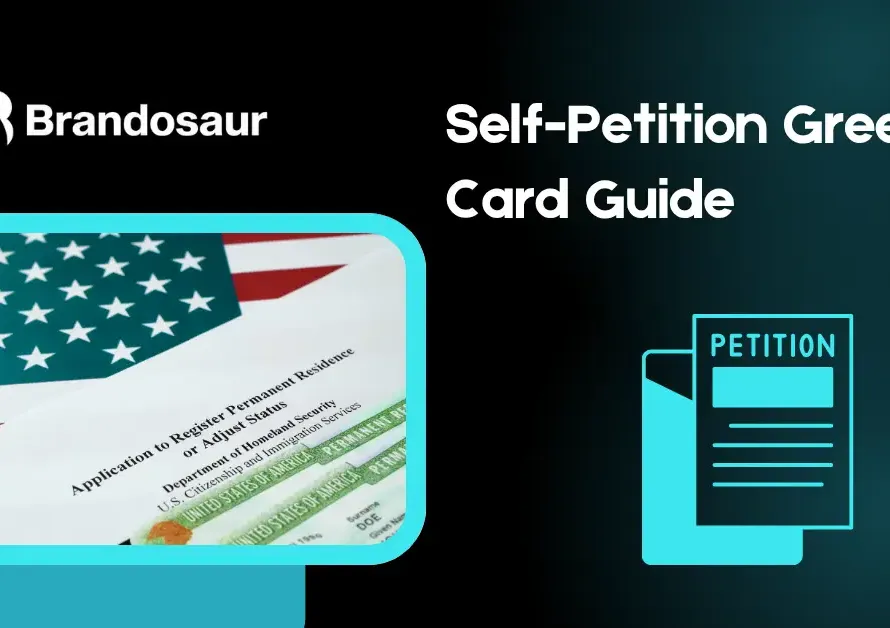How to Get a Green Card Without Marriage in the USA (2025): EB1A Visa Path
- Brandosaur
- August 19, 2025
- 1:12 pm
Many people assume that marriage to a U.S. citizen is the only way to get a green card. In reality, you can get a green card without marriage if you qualify under other categories. One of the most powerful options is the EB1A category for individuals of extraordinary ability. This self-petition path lets top achievers in fields like science, art, education, business, or athletics apply directly for a green card, no employer sponsor or spouse required. USCIS reports that over 40,000 people per year secure U.S. permanent residency through self-petition routes (EB1A, EB2 NIW, EB5, VAWA, etc.).
This guide explains what is EB1A, outlines the EB1A criteria and EB1A visa requirements, walks through the EB1A process, and covers filing fees, processing times, and success rates. We also answer common questions about non-marriage green card options. And yes, if you have an extraordinary ability, you can get a green card without marriage under the EB1A category.
What is EB1A (Extraordinary Ability)?
EB-1A (Alien of Extraordinary Ability) is an employment-based, first-preference green card category for people who have reached the very top of their field. USCIS defines “extraordinary ability” as sustained national or international acclaim, meaning your achievements place you in the small percentage who are the best in your domain. Typical examples include Nobel Prize winners, Olympic medalists, Pulitzer Prize recipients, or top executives and researchers.
Importantly, the EB1A visa does not require a job offer or employer sponsorship. In other words, you can self-petition for an EB1A green card on your own behalf. This makes EB1A a “green card without a sponsor” path, and by extension, without needing marriage. As the USCIS immigration website explains, no offer of employment or labor certification is required for EB1A. In practice, this means a world-renowned software engineer, artist, or scientist can apply directly for permanent residency. (Brandosaur’s Self-Petition Green Card Guide shows that thousands of people use EB1A and similar options to immigrate on their own.)
EB1A Eligibility Criteria
To qualify for EB1A, you must meet strict criteria demonstrating your extraordinary ability. There are two paths: either (a) you have a one-time major international award (like an Oscar, Nobel, Olympic Medal, etc.), or (b) you must satisfy at least three of USCIS’s ten listed criteria. No matter the path, you must also show that you will continue working in your field of expertise.
The EB1A criteria (the ten evidentiary categories) include:
- Prestigious Prizes/Awards: Receipt of nationally or internationally recognized prizes for excellence (e.g., scientific or industry awards).
- Association Membership: Membership in elite professional associations that require outstanding achievements of members.
- Published Material: Articles or media coverage about you or your work in prominent trade journals or mainstream media.
- Judging Others: Invitations to judge the work of others (e.g., serving on expert panels, conferences, or as a peer reviewer).
- Original Contributions: Evidence of significant original work or innovation (such as patents, new technologies, or major discoveries) that has a major impact in your field.
- Authorship: Authorship of scholarly articles or books in respected journals or media.
- Artistic Exhibitions: (Arts only) Participation in major exhibitions or showcases of your work.
- Leading Roles: A leading or critical role in distinguished organizations (e.g., principal engineer at a major tech company or lead designer on a landmark project).
- High Salary: A salary or remuneration significantly higher than peers in your field (often interpreted as top 5% by industry standards).
- Commercial Success: Evidence of commercial success in the arts or other fields (e.g., box office receipts, best-selling products, widely used software).
Each piece of evidence should be well-documented and tied clearly to one of the criteria. USCIS will review all submitted evidence to decide if you truly stand at the pinnacle of your field. If you do not have a Nobel Prize–level award, you’ll typically need to submit evidence in at least three of the categories above. Brandosaur’s EB1A guides note that strong cases often use more than three criteria for a compelling story. (See USCIS policy manual for full details.)
In summary, the EB1A criteria ensure only the most accomplished qualify, but if you do qualify, you get a direct route to a green card without marriage or an employer.
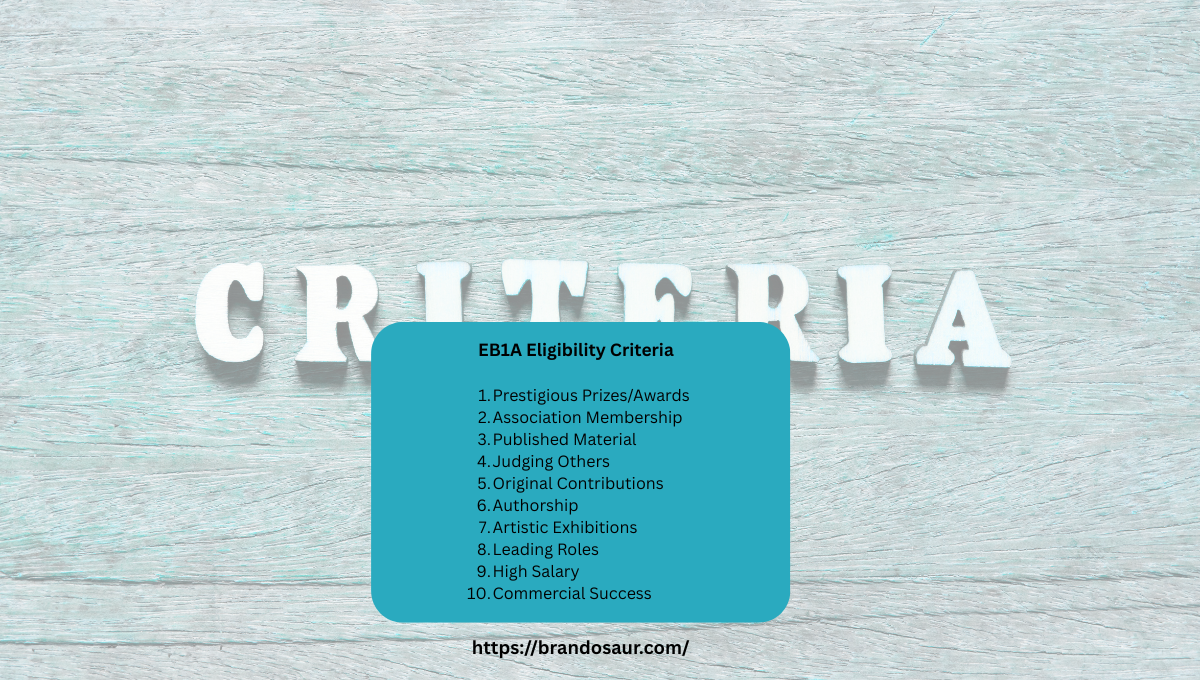
EB1A Visa Requirements and Process
Once you have enough evidence to meet EB-1A requirements, the application process involves the following steps:
1) Prepare and File Form I-140 (Immigrant Petition for Alien Worker)
You compile all your supporting documents (awards, publications, letters, etc.) and file Form I-140 with USCIS. This petition must clearly tie each piece of evidence to the EB1A criteria. (Many applicants include a detailed cover letter explaining how they meet the criteria.) Since EB1A is self-petition, you do not need a U.S. employer or labor certification.
2) Pay Filing Fee
Include the EB1A filing fee for the I-140 form. (As of 2024, the I-140 fee is $700, though USCIS has announced new fees effective July 2025; check the USCIS fee schedule for updates.)
3) Premium Processing (Optional)
If you want a faster decision, you can pay extra for premium processing. USCIS guarantees a decision on the I-140 in 15 days with premium processing. Under regular processing, expect about 4–7 months for an EB1A I-140 decision.
4) Receive USCIS Decision on I-140
If approved, USCIS finds that you meet the EB1A criteria. If denied, you may get an RFE (Request for Evidence) or be able to appeal or reapply. The approval lets you move to the next step toward a green card.
5) Adjustment of Status or Consular Processing
- If you are already in the U.S. on a valid status, you can file Form I-485 to adjust status to permanent resident once your I-140 is approved (if a visa is immediately available).
- If you are outside the U.S., you go through consular processing. You’ll wait for National Visa Center (NVC) processing and attend an immigrant visa interview at a U.S. embassy or consulate.
- For EB1A, visas are usually current, so you can often file I-485 or attend the visa interview immediately after I-140 approval.
6) Green Card Issuance
If all goes well, USCIS (or the consulate) will grant your green card. If you are married less than 2 years at approval (and you applied based on marriage, which isn’t the case here), you would get a conditional 2-year card. But under EB1A, your green card is permanent (10-year) from the start.
Throughout this EB1A process, accuracy and thorough documentation are critical. Organize your evidence logically and avoid missing items. Brandosaur’s EB1A profile guides emphasize building a strong narrative that clearly shows you meet the criteria. At each step, you retain the same extraordinary ability evidence; the key is that your I-140 petition fully demonstrates your qualifications.
Below is a summary table of typical EB1A processing times:
Step | Typical Processing Time |
I-140, EB1A petition (regular) | ~4–7 months |
I-140, EB1A petition (premium) | ~15 calendar days |
Consular Processing (visa stamp) | ~6–10 months after I-140 approval |
Total from I-140 to Green Card | ~8–24 months |
These are estimates: actual times vary by USCIS workload and individual cases. Premium processing can expedite I-140 adjudication, but note that it costs extra (currently $2500) and does not affect the I-485/adjudication time.
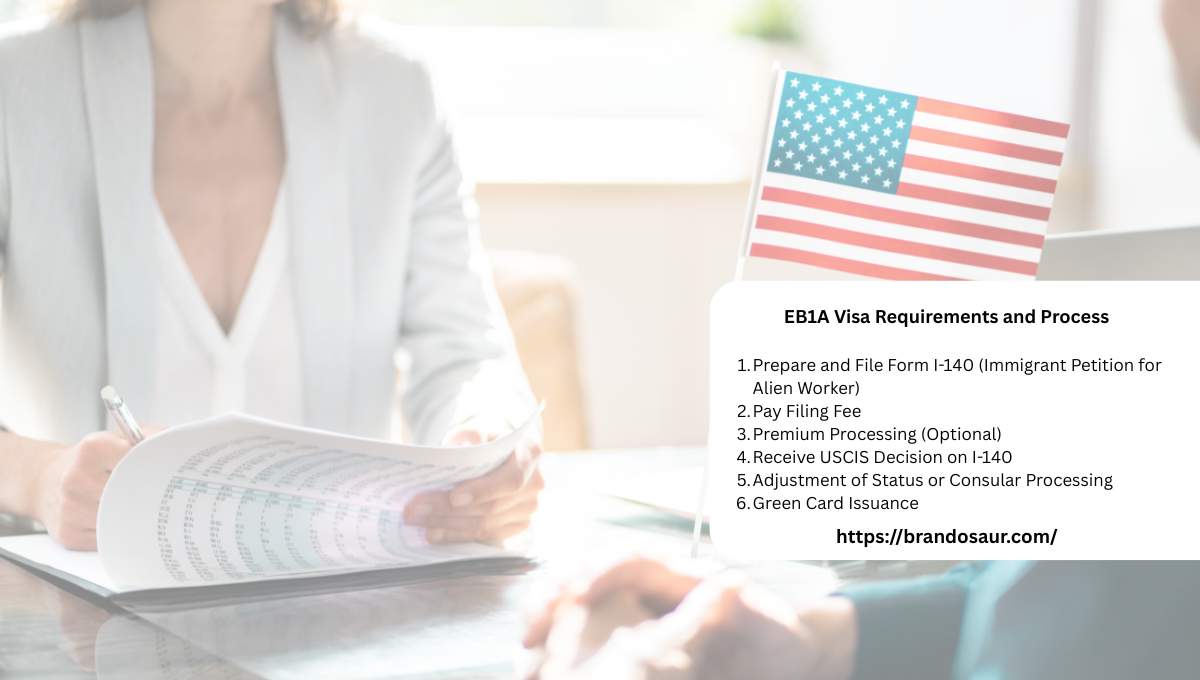
EB1A Filing Fee, Processing Time, and Success Rate
1) EB1A Filing Fee
To file the EB1A petition (Form I-140), you must include the I-140 filing fee (currently $700 for most applicants, as per USCIS fee schedule). USCIS announced updated fees effective July 22, 2025, so always verify the latest fee. The fee is non-refundable once paid.
2) EB1A Processing Time
As shown above, regular I-140 processing is typically 4–7 months, though USCIS can take longer. With premium processing, you get a decision in ~15 days. After I-140 approval, adjustment or consular processing adds roughly 6–12 months. Overall, most EB1A cases are completed in under two years.
3) EB1A Success Rate
Approval rates for EB1A can vary. According to recent USCIS data, about 60.7% of EB1A petitions were approved in fiscal year 2024 (with ~23% denied), a lower rate than prior years. By comparison, EB1B (outstanding researchers) had about an 84.6% approval rate in 2024. These figures show EB1A is competitive, so a well-documented case is essential. (Before 2024, EB1A approval rates were higher, e.g., ~70% in 2023.)
In short, planning and expert help can improve your odds. Need help with your EB1A petition? Get EB1A consultation! Brandosaur’s immigration experts can guide you through preparing the strongest application.
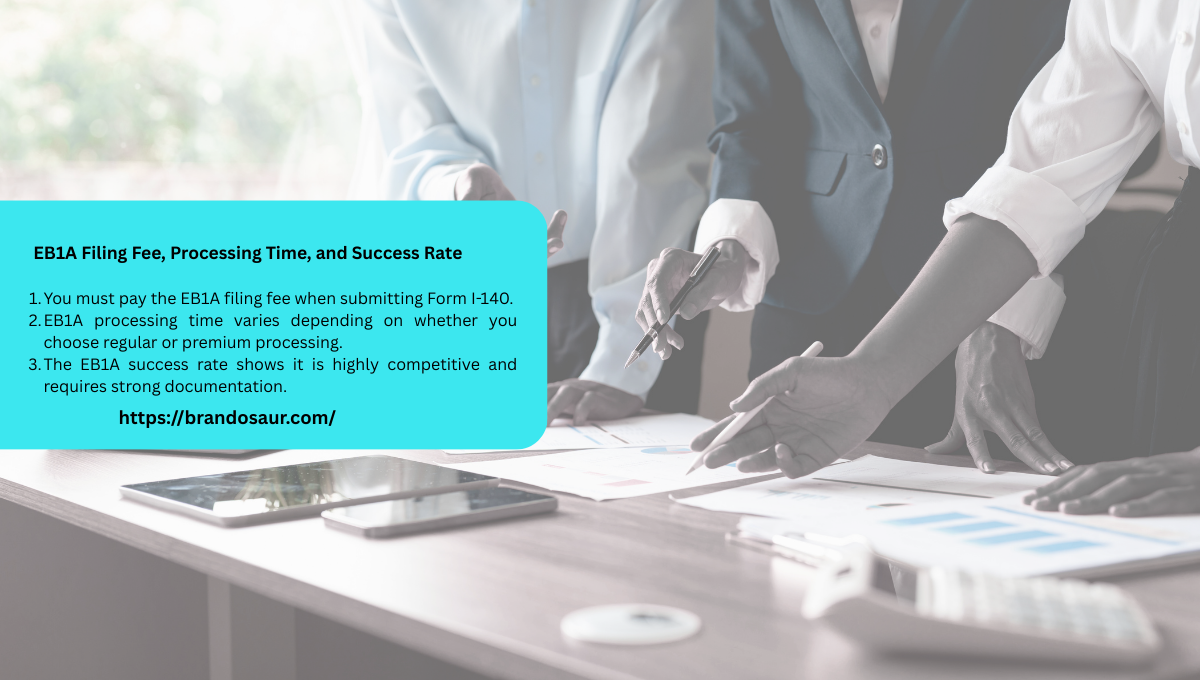
Alternative Green Card Paths Without Marriage
While EB1A is a top option for those with extraordinary talent, other self-petition green card categories also exist:
- EB2 NIW (National Interest Waiver): Advanced degree professionals or exceptional ability workers whose work benefits the U.S. can self-petition under EB2 NIW without employer sponsorship. It has similar documentary requirements (original contributions, publications, etc.).
- EB5 Investor Visa: Investing $800,000+ in a U.S. business (creating jobs) can lead to a green card.
- VAWA: Certain abuse survivors can self-petition (without spouse involvement) for a green card.
- Diversity Visa Lottery: A random lottery for citizens of eligible countries; winners get green cards.
Each has its own rules and eligibility. But for high achievers seeking a direct route, EB1A is often the most straightforward way to a green card without any family sponsor.
EB1A offers a self-petition green card for extraordinary achievers, no marriage or employer sponsor needed. To qualify, you need major awards or meet multiple EB1A criteria (3 of 10). The EB1A process involves filing Form I-140 with documentation, paying the filing fee, and then adjusting status or consular processing. Typically, I-140 approval takes 4–7 months (15 days with premium), and the total time to a green card is under 2 years.
The current EB1A success rate is around 60–70%. In summary, yes, you can get a U.S. green card without marriage if your achievements meet the EB1A standard. For personalized help, Need Help with Your EB1A Petition? Get EB1A consultation! Our experts can guide you through building a winning petition.
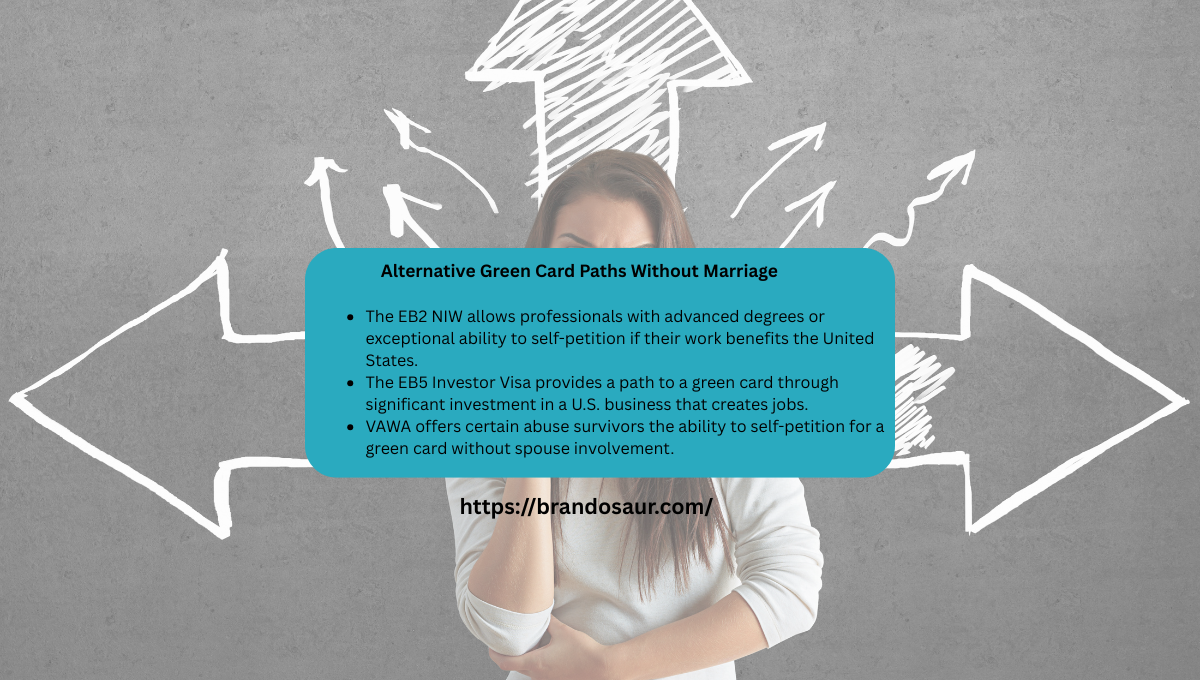
FAQs
Q1: Can I bring my unmarried partner to the USA?
Ans: No. U.S. immigration does not recognize “unmarried partners” as a basis for sponsorship. Only legally married spouses (and, in limited cases, fiancés via a K-1 visa) have specific immigration options. An unmarried partner cannot be brought to the U.S. through a green card petition. (If you marry your partner, you could then sponsor them, or vice versa.) In short, if you are not married (and not engaged under K-1), there is no direct immigration route for your partner. Each person would need to qualify independently (e.g., via their own employment category).
Q2: Can I stay in the US while waiting for a marriage green card?
Ans: You cannot legally remain in the U.S. simply “while waiting” if you are out of status. If you entered the U.S. on a visa (student, tourist, etc.) and that visa expires before your marriage-based petition is approved, you could lose your status. You must maintain your own legal status in the meantime (for example, by having a valid work or student visa). If you marry a U.S. citizen while in the U.S. lawfully, you can immediately file Form I-485 to adjust status and stay pending that application. But if you are waiting to marry and have no valid status, you would generally need to leave the U.S. and consular process for the green card after marriage.
Q3: How long do you have to be married in America to get a green card?
Ans: There is no minimum marriage duration before applying; you can file once you have legally married a U.S. citizen or permanent resident. However, if your marriage is less than two years old when your green card is granted, USCIS will issue you a conditional green card valid for two years. You must then file to remove conditions (proving the marriage was bona fide) to get a regular 10-year card. If you have been married for more than two years at the time of approval, you receive a permanent 10-year green card immediately (no conditions).




